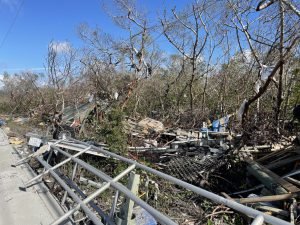As a hurricane-prone state, Florida knows all too well the concerns that come with hurricanes — storm surge, hazardous debris, dangerous wind speeds.
Join our family of readers for as little as $5 per month and support local, unbiased journalism.
Already have an account? Log in to continue. Otherwise, follow the link below to join.
Please log in to continue |

As a hurricane-prone state, Florida knows all too well the concerns that come with hurricanes — storm surge, hazardous debris, dangerous wind speeds. But what about wildfires?
Though wildfires aren’t usually the first concern after a hurricane, they are a major threat in the aftermath of one. This is because storms disrupt and displace much of the vegetation in a landscape, increasing the amount of fuel that is available to burn and subsequently cause wildfires, said David Godwin, director of the Southern Fire Exchange and a fire ecologist with the UF/IFAS School of Forest, Fisheries, and Geomatics Sciences.
For example, when Hurricane Michael hit in 2018, it damaged over 2.5 million acres of forested land and left a mess of debris that fueled last year’s Panhandle wildfires. To make matters even worse, Godwin added, many of the damaged trees fell on private lands, meaning entities like the Florida Forest Service couldn’t just go in and clean it up.
While displaced trees, leaves and other vegetation increase the chances for wildfires, they also complicate firefighting. The heap of vegetation makes the areas not only hard to access but dangerous for firefighters as they must navigate over, under and around burning debris. Likewise, vehicles and most bulldozers can’t get in.
This proved especially difficult in the Panhandle as fire management services had to resort to bringing in more bulldozers or larger bulldozers to help create fire lines to contain the fires.
For residents concerned about wildfire risk from hurricane debris on their own property, Godwin shares some advice:
“Those who live near an area with a lot of trees and vegetation should immediately clean up the property around their home to help reduce the risk of wildfires. They should also move flammable fuels like firewood, propane tanks and fuel tanks away from their home,” he said.
But what about hurricanes that affect a less forested or coastal area, like much of the area Hurricane Ian went through? Godwin shares that fires can start via other sources that are commonly found in areas after hurricanes.
“For one, hurricane storm surge can displace items like boats, propane tanks, appliances and tires,” Godwin said. “If these new and foreign hazardous materials are in places where a wildfire occurs, the effects could be particularly dangerous.”
Wet vegetation, or materials that are just dry enough to catch fire but just wet enough to only produce smoke, like rotten logs and storm-surge deposited seaweed, are also a concern.
Wet materials can burn very slowly and for a long time, producing a lot of smoke, Godwin said. Such smoke can make roadways more dangerous to drive and create a recipe for traffic accidents.
Regardless of year or circumstance, there will always be fires in Florida, Godwin said. These fires can either be wild or prescribed, and the latter is the best of the two.
“It’s a matter of being proactive or reactive,” Godwin said, “Prescribed fires are proactive, and for many places they are the best way to reduce fuels on land and benefit our plants and animals.” He also added that prescribed burning is one of the tools to limit the intensity and spread of a wildfire if one were to occur.
“Wildfires don’t know property lines and they don’t stop at the fence,” Godwin said. “When it comes to protecting each other and our environment from wildfires, we’re all on the same team.”